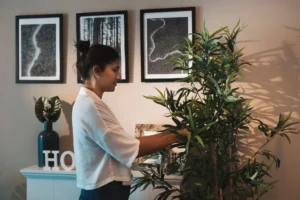
Home renovations are exciting but come with a delicate balancing act: modernizing your space while preserving the charm and character that make it uniquely yours. Whether you live in a historic Victorian, a cozy Craftsman, or a mid-century gem, the goal is to enhance functionality and aesthetics without erasing the soul of your home. Below are 10 practical tips to guide your home renovation journey while keeping your home’s beauty intact.
1. Understand Your Home’s Architectural Style
Before swinging a sledgehammer, research your home’s architectural heritage. Every design era—from Colonial to Art Deco—has distinct features, materials, and proportions. For example, Victorian homes often showcase ornate trim, stained glass, and asymmetrical facades, while mid-century modern designs emphasize clean lines and open floor plans.
- Research: Study historical photos, blueprints, or neighborhood homes of the same era.
- Consult Experts: Architects or preservationists can identify “character-defining elements” worth saving.
- Respect the Bones: Avoid altering rooflines, window placements, or foundational layouts that define the home’s silhouette.
By honoring the original style, your updates will feel cohesive rather than jarring.
Read more: 10 Steps to a Perfectly Lit Kitchen, According to a Pro2. Preserve Original Features
Original details are irreplaceable and often crafted with superior materials. Salvage and restore elements like:
- Hardwood Floors: Refinish instead of replacing. Aged wood adds warmth and history.
- Moldings and Trim: Repair dented crown molding or baseboards rather than installing generic replacements.
- Fireplaces and Mantels: Restore tile surrounds or carved wood mantels as focal points.
- Built-Ins: Refresh vintage bookshelves or window seats with fresh paint or hardware.
Even small features, like doorknobs or hinges, contribute to the home’s narrative. If removal is unavoidable (e.g., for electrical work), store materials for reuse.
3. Modernize Systems Without Sacrificing Aesthetics
Upgrading plumbing, electrical, and HVAC systems is essential for safety and comfort, but tech shouldn’t overshadow charm.
- Conceal Wiring: Hide TV cables or smart home devices behind walls or within built-in cabinets.
- Vintage-Inspired Fixtures: Choose Edison-style bulbs, clawfoot tub faucets, or brass switch plates that nod to the past.
- Discreet HVAC: Opt for slim ductwork or mini-split systems instead of bulky vents that clash with historic interiors.
Blending modern convenience with period-appropriate design keeps functionality subtle.
4. Choose Materials That Complement the Original Design
Whether repairing a porch or retiling a bathroom, select materials that harmonize with the home’s era.
- Replicate Originals: Source reclaimed wood, brick, or tile to match existing surfaces.
- Avoid Trendy Overhauls: A marble-clad kitchen might clash in a farmhouse, while subway tiles suit both traditional and modern spaces.
- Prioritize Craftsmanship: Hand-scraped wood floors or custom millwork echo the artisanal quality of older homes.
For extensions, use materials that age gracefully, like copper gutters or cedar shingles, to maintain visual continuity.
5. Focus on Symmetry and Proportion
Many older homes were designed with balanced proportions. Preserve this harmony when making changes:
- Window Consistency: Keep original sizes and styles; avoid enlarging or shrinking openings.
- Ceiling Heights: Don’t lower ceilings to accommodate ductwork—explore alternative solutions.
- Room Layouts: Maintain flow between rooms; avoid chopping up spaces in ways that disrupt natural pathways.
Even modern additions should mirror the scale and rhythm of the existing structure.
6. Update Color Schemes Thoughtfully
Color can modernize a space without erasing its history.
- Historical Palettes: Research period-appropriate hues (e.g., muted greens for a Craftsman, pastels for a Victorian).
- Neutral Backdrops: Soft whites or grays let architectural details shine while feeling fresh.
- Accent Walls: Use bold colors sparingly to highlight fireplaces or alcoves.
Test samples in natural light to see how tones interact with original woodwork or stained glass.
7. Incorporate Energy Efficiency Discreetly
Sustainability and preservation aren’t mutually exclusive:
- Storm Windows: Install interior storms to protect original windows while improving insulation.
- Insulation Upgrades: Use spray foam in attics or walls without altering historic finishes.
- LED Lighting: Choose fixtures with vintage designs to reduce energy use subtly.
- Solar Panels: Place panels on rear roofs or ground mounts to minimize visual impact.
8. Respect the Original Floor Plan
Open-concept layouts dominate modern design, but they can strip older homes of their compartmentalized charm.
- Preserve Rooms: Keep formal dining rooms, parlors, or sunrooms intact if they suit your lifestyle.
- Connect Spaces Gently: Use arched doorways or glass-paned doors to create flow without demolishing walls.
- Additions: If expanding, mirror the home’s proportions and connect new spaces via conservatories or sunrooms.
9. Blend Old and New in Décor
Furnishings and decor bridge the gap between eras:
- Mix Antique and Modern: Pair a farmhouse table with contemporary chairs or hang abstract art in a traditional hallway.
- Layer Textures: Combine linen curtains, Persian rugs, and metallic accents for depth.
- Highlight Eras: In mid-century homes, use sleek furniture; in colonials, opt for Windsor chairs and quilts.
This approach keeps interiors dynamic yet rooted in history.
10. Work With Preservation-Minded Professionals
Not all contractors understand historic homes. Seek experts who value conservation:
- Architects: Look for experience in adaptive reuse or historic tax credit projects.
- Craftsmen: Hire artisans skilled in plaster repair, stained glass, or woodworking.
- Designers: Choose those who prioritize “restoration over replacement” in their portfolios.
Read more: How to Remove Carpet in 10 Easy StepsConclusion: Beauty Lies in Balance
Renovating a home with its beauty intact requires patience, research, and respect for the past. By focusing on preservation-minded upgrades—whether saving original floors, blending eras in decor, or discreetly adding modern comforts—you create a space that honors history while meeting contemporary needs. Remember, a home’s character isn’t just in its walls but in the stories embedded in its details. With thoughtful planning, your renovation can ensure those stories endure for generations.






1 Comment
I am really inspired together with your writing abilities as well as with the format to your weblog. Is this a paid topic or did you customize it yourself? Either way stay up the excellent high quality writing, it is uncommon to see a nice weblog like this one nowadays!